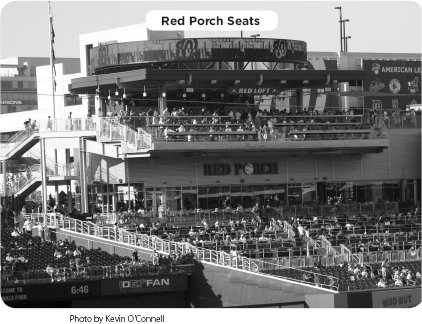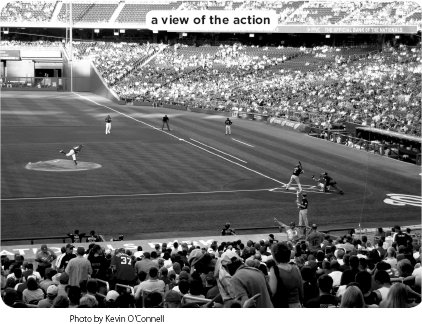Ultimate Baseball Road Trip (29 page)
Read Ultimate Baseball Road Trip Online
Authors: Josh Pahigian,Kevin O’Connell

Seating Capacity:
41,546
Ticket Office:
http://washington.nationals.mlb.com/ticketing/index.jsp?c_id=was
Seating Chart:
http://washington.nationals.mlb.com/was/ticketing/seating_pricing.jsp
The Home Plate Box seats are the upper seats in Sections A and E, while the rest of the Presidents Seats seem to be filled with the visiting dignitaries of such far off places as New Jersey and Philadelphia. Not a president of anything? Then you probably can’t afford these seats either.
Josh:
I was president of the Chess Club in high school.
Kevin:
Not sure that’s going to count for much.
Josh:
Yeah, I don’t think it did on my college applications either.
These behind-the-plate beauts will cost you as well, though the Diamond Seats do offer Diamond Club access, and that means higher-end food options. Look for these bad boys on ticket broker websites and from “connected” friends only.
The Infield Box seats represent the upper seats in the section, while the Home/Visitor Dugout Box Seats are the lower seats in the section. Adjust your wallet accordingly.
The Baseline Box seats are along the field while the Reserved Seats are the upper seats in the section. They’re all good seats with great views and they’re priced at a point where you might not need to take out a second mortgage to afford them.
Sections 136 and 137 have foul-pole blockage issues and should be avoided by those fans who find that bothersome. Some of the seats in these sections should have been left out or an aisle should have been put where the foul pole blocks the view.
Sections 101–105 are close to the action and comfortable and only lose sight of the warning track. They are much preferable to 138–143. The right-field seats are higher off the field, are in the sun, and sacrifice more of the field to sightline loss.
Avoid Section 107 as it has the foul pole running right down the middle of it, blocking the infield or outfield depending on where you sit. Avoid the left edge of Section 138 (as you face the plate) for the same foul-pole-related reason.
The lower seats in Sections 101–103 offer good access to the very open visiting team’s bullpen. For gawking into the home bullpen, get a low seat in Sections 137–140.
This is Red Porch party area and most of the young urban hipsters in this section are paying more attention to getting each other’s phone numbers than the game. But if they were paying attention, they’d find a decent outfield seat … but one not really worth the price unless you plan on cashing in on the full amount of the discount at the Red Porch Restaurant.

These Club Level seats are meant to be enjoyed by the regular fans, or at least those who don’t mind overpaying for tickets. With the price of admission, ticket holders enjoy access to all the benefits inherent to being a member of the club.
Kevin:
Which is what exactly?
Josh:
The opportunity to hobnob and pay more for food.
Kevin:
Okay, that’s what I thought.
The sight lines are pretty good in the upper decks, but they are hot and unprotected from the sun, so bring the sun-screen or sit on the left side of the ballpark where the seating structure will protect you from the rays during the early innings of evening games. During day games, well, you’re pretty much out there in the sun wherever you go.
The Pros and Cons of Seat-Hopping
Some call it seat-hopping, others refer to it as seat poaching. Either way, it’s a practice you approach either with confidence, or not at all. This little guide will give you everything you need to seat-hop with the best of ’em. Here are the commandments according to Kevin and Josh:
- Arrive Early, Move Often. Getting to a choice seat during batting practice is key if you want to sit very close to the action. It’s the only time that ushers will allow you into the choice sections without looking over your ticket. When the ushers come through to clear the section after batting practice ends, stay one step ahead of them and never let them get near enough to you to ask for your seat. Remember, they’re busy. Soon enough, they will get distracted and you’ll have the chance to plop down and let them forget about you.
- The Usher Is Not Your Friend. An usher may look like a kindly older man who scored a nice little retirement job earning extra cash while he enjoys the ball game, but make no mistake: Ushers are the seat-hopper’s enemy. If they detect your indiscretions, they will track you down and toss you out just because some boss told them to. Avoid contact with the enemy at all costs.
- Don’t Get Greedy. If an empty seat looks too good to be true, it probably is. Ushers are at the park every night, and know the faces of the season-ticket holders. They know which regulars never miss a game, and which loan their tickets out. Your best bet is to try to be mistaken as one of the latter category. And you should use whatever means of deception and trickery you have at your disposal.
- Learn to Read Their Faces. Like a Vegas Hold ’Em tournament champ, the experienced seat-hopper knows how to judge the situation by looking out of the corner of the eye. He can tell instantly through body language and facial expressions of the ushers who will make them move and who will let them slide to another seat because they don’t like confrontation. It’s a fight-or-flight moment, one that dictates your next action. Depending on your ability to forecast the future, you’ll have three choices when a ticket holder approaches:
a. Stand pat and let them engage you. Here you’re either betting they are looking for the open seats next to you, won’t bother with talking to you about being in their seats and will sit elsewhere themselves, or you feel as if you can comfortably laugh things off as an honest mistake without causing too much commotion.
b. The Preemptive Move. This is used when you know by reading their body language that they seem irritable or uptight, and there are seats nearby that you can quickly and easily slide into.
c. The All-Out Retreat. This move is only necessary in the most desperate of circumstances, like trying to poach seats behind home plate where free food has been offered and consumed. The all-out retreat is complete withdrawal from a section to save yourself from being booted from the area of the park altogether.
- Always Have Your Next Move in Mind. Even as the innings roll past, the experienced seat hopper thinks ahead to his next move, because there is no telling for sure when the ticket holder might return. Like a chess match, the more moves you can think ahead, the better your chances for survival and victory.
- Don’t Seat-Hop at Ballparks that Sell Out Regularly. It simply is more trouble than it’s worth. You’ll have to judge for yourself whether the game will have enough empty seats for you to pluck a beauty, but a good indicator is how the ballpark looks twenty minutes before game time. If it’s relatively empty, you should have a decent chance of finding a semi-permanent home.
- If All Else Fails—Plead Ignorance. Tell them you got confused. Tell them you’re from the backwoods and it’s your first-ever trip to the big city and you’re out of your element. Tell them the ink on the tickets smudged or is too small to read. Heck, tell them you had a massive head injury, but do not ever admit that you knowingly tried to sit in someone else’s seat. It just isn’t considered good form.
Remember, Be Bold and Happy Seat-Hopping!
Section 201 has a bit of a foul-pole obstruction. Section 231 has a slight underhang issue and the right-field corner disappears in this section, as well as from 229 and 227(barely). Sections 233 and 235 have foul-pole obstructions that are significant. The pick of the litter of the Mezzanine Level (other than the club seats) is Sections 223 and 225, with 223 being better.
All of these sections have underhang issues that cause loss of sight lines of the warning track and the right-field corner. They are by no means horrible losses of sight lines, but they have not been perfectly protected either.
This level, like the ones above it, is not as high up as it could be, because the Nationals made one very good decision in putting the press box and the Shirley Povich Media Center above the seating areas rather than giving them their own level, which would have pushed the upper decks farther into the stratosphere. As a result, visiting announcers often complain that Nationals Park offers them the worst vantage point of any big league park. To this we say, now you know how we upper deck fans have felt for years!
How they get away with calling these 200-Level seats is beyond us. There are three full seating decks in this ballpark, and these seats are clearly on the third level. Seats behind the plate in the Gallery-level are far superior to these poorly named stinkers. Underhang issues don’t affect 222–226, but do affect parts of section 228. Sections 230–236 should be avoided as seat holders face an underhang that will cause them to lose sight of the right fielder, foul-pole issues, and the glare of the sun. All in all, we recommend avoiding these seats altogether.
Josh:
They’re for the suckers who didn’t buy our book.
Kevin:
When will they ever learn? They could have had better seats, made up the money they blew on the tickets, and kept the book as well.
The Gallery Level sections only go nine rows deep to the top of the concourse. Because of the stacked deck design, these seats feel pretty high up, but are not bad at all. Sight lines are protected throughout most of the sections, except where noted below.
These are actually great seats for the price, with good sight lines from high above the action. We’d sit here anytime, but you won’t find the good food options you have down below. Sections 314–321 offer views of the Capitol but are in the sun, while 306–314 provide more shade. Sections 302–305 are the Outfield Gallery seats and are pushed a bit farther down the line, and lose a bit of left-field corner. But they’re cheaper, so pick your poison. Section 301 should be avoided because the foul pole comes into play, and you can do much better one section over.
Even these sight lines are good. The stacked design eliminates the underhang issue and puts you right on top of the action. These seats are high and the deck is steep, but you have a completely unobstructed view of the game.
You’ll find still very nice seats in this level with good views. Just bring the good food up with you or get it before the game. Section 403 loses just the slightest bit of the left-field corner.

Though you do lose the slightest bit of the left-field corner in these seats, it’s less of a loss than the even numbered 200-level seats in the Upper Right Field Terrace sections. Section 401 is for the folks who want to maximize their bird’s-eye view—of the ballpark, the ballgame, and the sunset going down over the Capitol.
